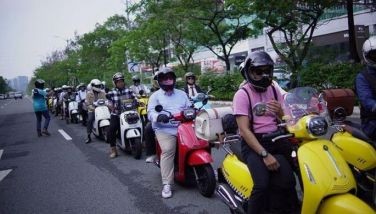Hyundai launches bold-faced ’04 Starex
May 12, 2004 | 12:00am
It’s no secret that the clannish Filipino loves vans. How else would you explain why a market remains for a two-decade-old model like the Mitsubishi L300 VersaVan? Or why every car company that has a van model is quick to make sure that their van is available here?
But among the many vans that traverse our metro streets, few have been quite as popular and admired as Hyundai’s Starex. For almost seven years, the Starex has been the darling of the gray market, unofficially becoming one of the best-selling models, if not the best-selling model, in the country. But with the entry of an official Philippine Hyundai distributor in Hyundai Asia Resources Inc. (HARI) and the subsequent putting up of official Hyundai dealers, the brand finally has the reliable after-sales service worthy of the van’s popularity.
Not that demand is dwindling. On the contrary the Starex is still deemed by many as one of the most desirable vans on the market. Not bad for a Korean carmaker that’s a newbie compared to industry veterans like Toyota, Nissan and Mitsubishi.
Still, the market is ever-competitive and woe to anyone caught sitting on one’s laurels. Which is why HARI introduced recently the 2004 Starex model. Most vehicle lifecycles include a mid-life facelift — and this is quite literally what the Starex received.
The front end is definitely attention-getting. It’s hardly what anyone would call pretty. It’s certainly a bold design, characterized by those glaring headlamp clusters and prominent vertical elements that form the big gaping grille. A new hood, front bumper and foglamps complete the dramatic makeover.
Addressing the sides and rear, the Hyundai people back in Korea probably subscribed to the axiom "don’t fix what’s not broken" and left well enough alone. New alloy wheels and taillight clusters and a few minor new touches combine with new color options to freshen up the Starex for war duty this cutthroat 2004.
Inside, the spacious cabin has been spruced up by a new color scheme designed to evoke a calmer ambience and a metal-framed instrument panel for a more luxurious feel. A new digital LED trip meter, an accessory power outlet and multi-purpose hangers mounted behind the seats increase functionality. To enhance safety, an improved braking system, headlights that turn on automatically, a safety lock for the sliding doors, back-up sensors and a driver-side airbag were added.
The tried-and-tested 2.5-liter 100-ps (with 23 kg-m of torque at a low 2000 rpm) intercooled turbodiesel engine mated to manual or automatic transmissions are carried over as are the independent double wishbone with torsion bar spring front and 5-link coil spring rear suspension.
The 2004 Starex models come in 10- or 12-passenger versions and start at P999,500 for the manual transmission-equipped GRX model and tops out at P1.3 million for the top-of-the-line Gold model with automatic transmission.
But among the many vans that traverse our metro streets, few have been quite as popular and admired as Hyundai’s Starex. For almost seven years, the Starex has been the darling of the gray market, unofficially becoming one of the best-selling models, if not the best-selling model, in the country. But with the entry of an official Philippine Hyundai distributor in Hyundai Asia Resources Inc. (HARI) and the subsequent putting up of official Hyundai dealers, the brand finally has the reliable after-sales service worthy of the van’s popularity.
Not that demand is dwindling. On the contrary the Starex is still deemed by many as one of the most desirable vans on the market. Not bad for a Korean carmaker that’s a newbie compared to industry veterans like Toyota, Nissan and Mitsubishi.
Still, the market is ever-competitive and woe to anyone caught sitting on one’s laurels. Which is why HARI introduced recently the 2004 Starex model. Most vehicle lifecycles include a mid-life facelift — and this is quite literally what the Starex received.
The front end is definitely attention-getting. It’s hardly what anyone would call pretty. It’s certainly a bold design, characterized by those glaring headlamp clusters and prominent vertical elements that form the big gaping grille. A new hood, front bumper and foglamps complete the dramatic makeover.
Addressing the sides and rear, the Hyundai people back in Korea probably subscribed to the axiom "don’t fix what’s not broken" and left well enough alone. New alloy wheels and taillight clusters and a few minor new touches combine with new color options to freshen up the Starex for war duty this cutthroat 2004.
Inside, the spacious cabin has been spruced up by a new color scheme designed to evoke a calmer ambience and a metal-framed instrument panel for a more luxurious feel. A new digital LED trip meter, an accessory power outlet and multi-purpose hangers mounted behind the seats increase functionality. To enhance safety, an improved braking system, headlights that turn on automatically, a safety lock for the sliding doors, back-up sensors and a driver-side airbag were added.
The tried-and-tested 2.5-liter 100-ps (with 23 kg-m of torque at a low 2000 rpm) intercooled turbodiesel engine mated to manual or automatic transmissions are carried over as are the independent double wishbone with torsion bar spring front and 5-link coil spring rear suspension.
The 2004 Starex models come in 10- or 12-passenger versions and start at P999,500 for the manual transmission-equipped GRX model and tops out at P1.3 million for the top-of-the-line Gold model with automatic transmission.
BrandSpace Articles
<
>
- Latest
Latest
Latest
September 30, 2024 - 4:26pm
By EC Toledo | September 30, 2024 - 4:26pm
September 26, 2024 - 3:30pm
September 26, 2024 - 3:30pm
August 16, 2024 - 11:00am
By Euden Valdez | August 16, 2024 - 11:00am
Recommended



























